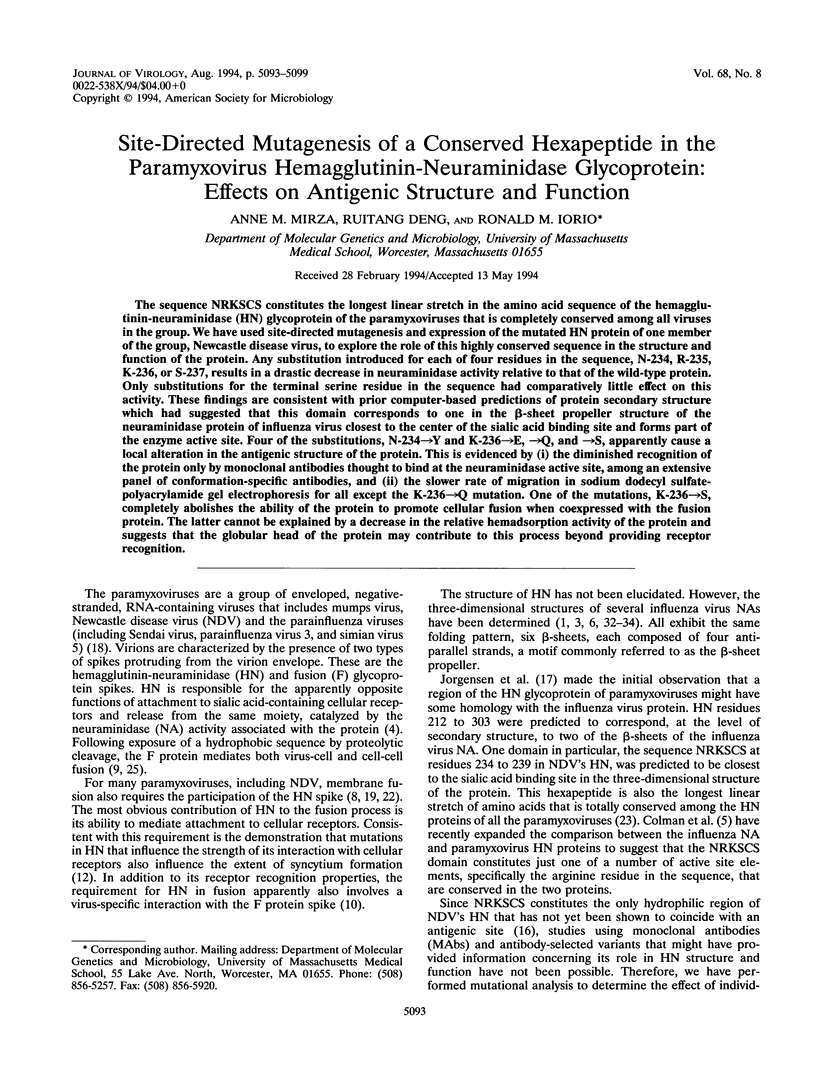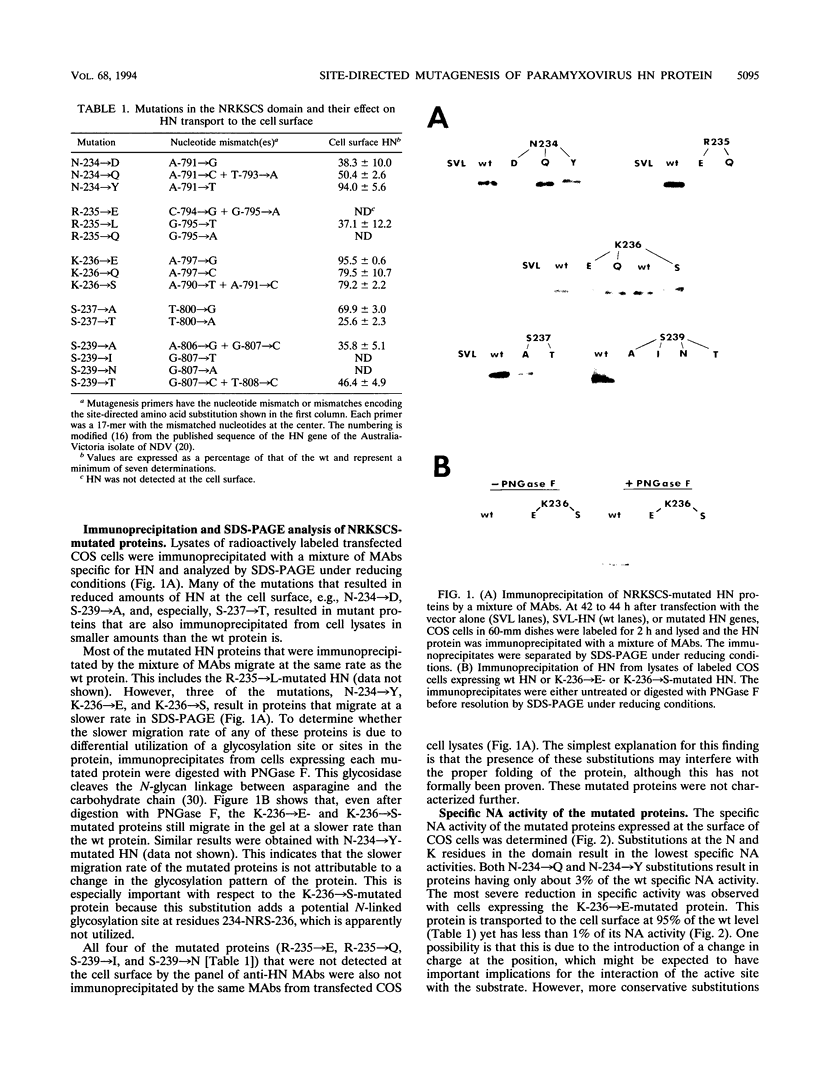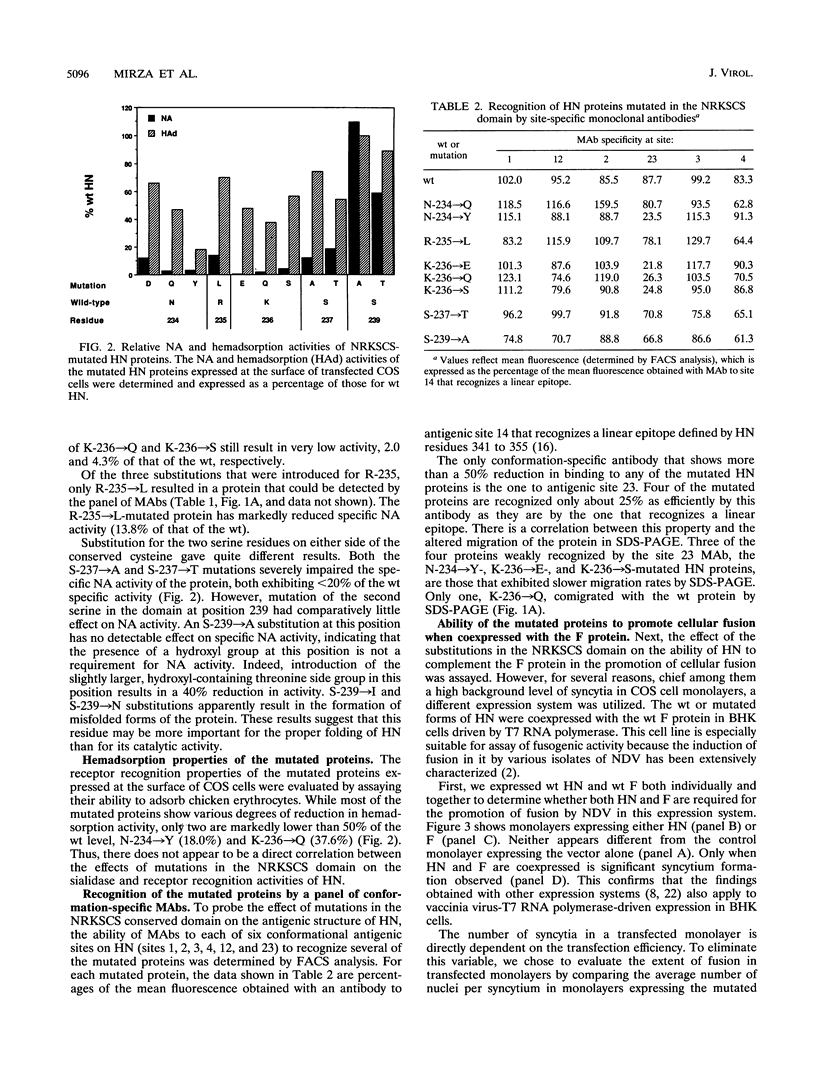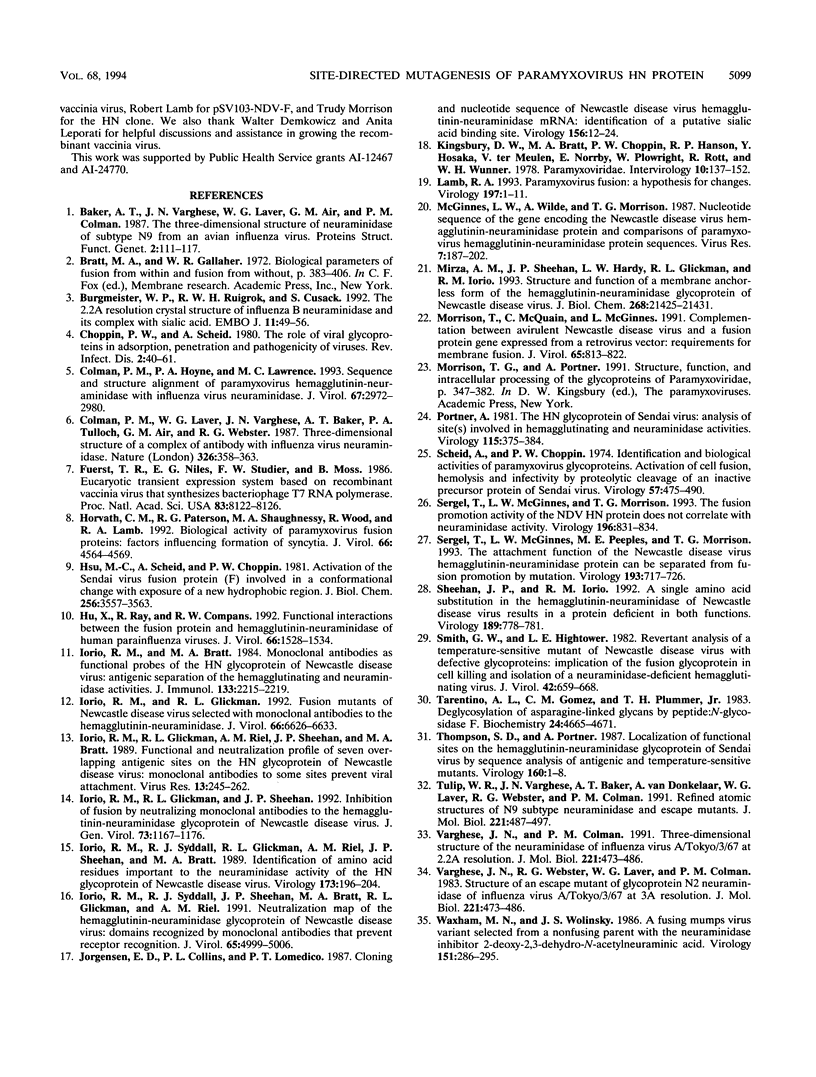Abstract
The sequence NRKSCS constitutes the longest linear stretch in the amino acid sequence of the hemagglutinin-neuraminidase (HN) glycoprotein of the paramyxoviruses that is completely conserved among all viruses in the group. We have used site-directed mutagenesis and expression of the mutated HN protein of one member of the group, Newcastle disease virus, to explore the role of this highly conserved sequence in the structure and function of the protein. Any substitution introduced for each of four residues in the sequence, N-234, R-235, K-236, or S-237, results in a drastic decrease in neuraminidase activity relative to that of the wild-type protein. Only substitutions for the terminal serine residue in the sequence had comparatively little effect on this activity. These findings are consistent with prior computer-based predictions of protein secondary structure which had suggested that this domain corresponds to one in the beta-sheet propeller structure of the neuraminidase protein of influenza virus closest to the center of the sialic acid binding site and forms part of the enzyme active site. Four of the substitutions, N-234-->Y and K-236-->E, -->Q, and -->S, apparently cause a local alteration in the antigenic structure of the protein. This is evidenced by (i) the diminished recognition of the protein only by monoclonal antibodies thought to bind at the neuraminidase active site, among an extensive panel of conformation-specific antibodies, and (ii) the slower rate of migration in sodium dodecyl sulfate-polyacrylamide gel electrophoresis for all except the K-236-->Q mutation. One of the mutations, K-236-->S, completely abolishes the ability of the protein to promote cellular fusion when coexpressed with the fusion protein. The latter cannot be explained by a decrease in the relative hemadsorption activity of the protein and suggests that the globular head of the protein may contribute to this process beyond providing receptor recognition.
Full text
PDF






Images in this article
Selected References
These references are in PubMed. This may not be the complete list of references from this article.
- Baker A. T., Varghese J. N., Laver W. G., Air G. M., Colman P. M. Three-dimensional structure of neuraminidase of subtype N9 from an avian influenza virus. Proteins. 1987;2(2):111–117. doi: 10.1002/prot.340020205. [DOI] [PubMed] [Google Scholar]
- Burmeister W. P., Ruigrok R. W., Cusack S. The 2.2 A resolution crystal structure of influenza B neuraminidase and its complex with sialic acid. EMBO J. 1992 Jan;11(1):49–56. doi: 10.1002/j.1460-2075.1992.tb05026.x. [DOI] [PMC free article] [PubMed] [Google Scholar]
- Choppin P. W., Scheid A. The role of viral glycoproteins in adsorption, penetration, and pathogenicity of viruses. Rev Infect Dis. 1980 Jan-Feb;2(1):40–61. doi: 10.1093/clinids/2.1.40. [DOI] [PubMed] [Google Scholar]
- Colman P. M., Hoyne P. A., Lawrence M. C. Sequence and structure alignment of paramyxovirus hemagglutinin-neuraminidase with influenza virus neuraminidase. J Virol. 1993 Jun;67(6):2972–2980. doi: 10.1128/jvi.67.6.2972-2980.1993. [DOI] [PMC free article] [PubMed] [Google Scholar]
- Colman P. M., Laver W. G., Varghese J. N., Baker A. T., Tulloch P. A., Air G. M., Webster R. G. Three-dimensional structure of a complex of antibody with influenza virus neuraminidase. 1987 Mar 26-Apr 1Nature. 326(6111):358–363. doi: 10.1038/326358a0. [DOI] [PubMed] [Google Scholar]
- Fuerst T. R., Niles E. G., Studier F. W., Moss B. Eukaryotic transient-expression system based on recombinant vaccinia virus that synthesizes bacteriophage T7 RNA polymerase. Proc Natl Acad Sci U S A. 1986 Nov;83(21):8122–8126. doi: 10.1073/pnas.83.21.8122. [DOI] [PMC free article] [PubMed] [Google Scholar]
- Horvath C. M., Paterson R. G., Shaughnessy M. A., Wood R., Lamb R. A. Biological activity of paramyxovirus fusion proteins: factors influencing formation of syncytia. J Virol. 1992 Jul;66(7):4564–4569. doi: 10.1128/jvi.66.7.4564-4569.1992. [DOI] [PMC free article] [PubMed] [Google Scholar]
- Hsu M., Scheid A., Choppin P. W. Activation of the Sendai virus fusion protein (f) involves a conformational change with exposure of a new hydrophobic region. J Biol Chem. 1981 Apr 10;256(7):3557–3563. [PubMed] [Google Scholar]
- Hu X. L., Ray R., Compans R. W. Functional interactions between the fusion protein and hemagglutinin-neuraminidase of human parainfluenza viruses. J Virol. 1992 Mar;66(3):1528–1534. doi: 10.1128/jvi.66.3.1528-1534.1992. [DOI] [PMC free article] [PubMed] [Google Scholar]
- Iorio R. M., Bratt M. A. Monoclonal antibodies as functional probes of the HN glycoprotein of Newcastle disease virus: antigenic separation of the hemagglutinating and neuraminidase sites. J Immunol. 1984 Oct;133(4):2215–2219. [PubMed] [Google Scholar]
- Iorio R. M., Glickman R. L. Fusion mutants of Newcastle disease virus selected with monoclonal antibodies to the hemagglutinin-neuraminidase. J Virol. 1992 Nov;66(11):6626–6633. doi: 10.1128/jvi.66.11.6626-6633.1992. [DOI] [PMC free article] [PubMed] [Google Scholar]
- Iorio R. M., Glickman R. L., Riel A. M., Sheehan J. P., Bratt M. A. Functional and neutralization profile of seven overlapping antigenic sites on the HN glycoprotein of Newcastle disease virus: monoclonal antibodies to some sites prevent viral attachment. Virus Res. 1989 Jul;13(3):245–261. doi: 10.1016/0168-1702(89)90019-1. [DOI] [PubMed] [Google Scholar]
- Iorio R. M., Glickman R. L., Sheehan J. P. Inhibition of fusion by neutralizing monoclonal antibodies to the haemagglutinin-neuraminidase glycoprotein of Newcastle disease virus. J Gen Virol. 1992 May;73(Pt 5):1167–1176. doi: 10.1099/0022-1317-73-5-1167. [DOI] [PubMed] [Google Scholar]
- Iorio R. M., Syddall R. J., Glickman R. L., Riel A. M., Sheehan J. P., Bratt M. A. Identification of amino acid residues important to the neuraminidase activity of the HN glycoprotein of Newcastle disease virus. Virology. 1989 Nov;173(1):196–204. doi: 10.1016/0042-6822(89)90235-3. [DOI] [PubMed] [Google Scholar]
- Iorio R. M., Syddall R. J., Sheehan J. P., Bratt M. A., Glickman R. L., Riel A. M. Neutralization map of the hemagglutinin-neuraminidase glycoprotein of Newcastle disease virus: domains recognized by monoclonal antibodies that prevent receptor recognition. J Virol. 1991 Sep;65(9):4999–5006. doi: 10.1128/jvi.65.9.4999-5006.1991. [DOI] [PMC free article] [PubMed] [Google Scholar]
- Jorgensen E. D., Collins P. L., Lomedico P. T. Cloning and nucleotide sequence of Newcastle disease virus hemagglutinin-neuraminidase mRNA: identification of a putative sialic acid binding site. Virology. 1987 Jan;156(1):12–24. doi: 10.1016/0042-6822(87)90431-4. [DOI] [PubMed] [Google Scholar]
- Lamb R. A. Paramyxovirus fusion: a hypothesis for changes. Virology. 1993 Nov;197(1):1–11. doi: 10.1006/viro.1993.1561. [DOI] [PubMed] [Google Scholar]
- McGinnes L. W., Wilde A., Morrison T. G. Nucleotide sequence of the gene encoding the Newcastle disease virus hemagglutinin-neuraminidase protein and comparisons of paramyxovirus hemagglutinin-neuraminidase protein sequences. Virus Res. 1987 May;7(3):187–202. doi: 10.1016/0168-1702(87)90027-x. [DOI] [PubMed] [Google Scholar]
- Mirza A. M., Sheehan J. P., Hardy L. W., Glickman R. L., Iorio R. M. Structure and function of a membrane anchor-less form of the hemagglutinin-neuraminidase glycoprotein of Newcastle disease virus. J Biol Chem. 1993 Oct 5;268(28):21425–21431. [PubMed] [Google Scholar]
- Morrison T., McQuain C., McGinnes L. Complementation between avirulent Newcastle disease virus and a fusion protein gene expressed from a retrovirus vector: requirements for membrane fusion. J Virol. 1991 Feb;65(2):813–822. doi: 10.1128/jvi.65.2.813-822.1991. [DOI] [PMC free article] [PubMed] [Google Scholar]
- Portner A. The HN glycoprotein of Sendai virus: analysis of site(s) involved in hemagglutinating and neuraminidase activities. Virology. 1981 Dec;115(2):375–384. doi: 10.1016/0042-6822(81)90118-5. [DOI] [PubMed] [Google Scholar]
- Scheid A., Choppin P. W. Identification of biological activities of paramyxovirus glycoproteins. Activation of cell fusion, hemolysis, and infectivity of proteolytic cleavage of an inactive precursor protein of Sendai virus. Virology. 1974 Feb;57(2):475–490. doi: 10.1016/0042-6822(74)90187-1. [DOI] [PubMed] [Google Scholar]
- Sergel T., McGinnes L. W., Morrison T. G. The fusion promotion activity of the NDV HN protein does not correlate with neuraminidase activity. Virology. 1993 Oct;196(2):831–834. doi: 10.1006/viro.1993.1541. [DOI] [PubMed] [Google Scholar]
- Sergel T., McGinnes L. W., Peeples M. E., Morrison T. G. The attachment function of the Newcastle disease virus hemagglutinin-neuraminidase protein can be separated from fusion promotion by mutation. Virology. 1993 Apr;193(2):717–726. doi: 10.1006/viro.1993.1180. [DOI] [PubMed] [Google Scholar]
- Sheehan J. P., Iorio R. M. A single amino acid substitution in the hemagglutinin-neuraminidase of Newcastle disease virus results in a protein deficient in both functions. Virology. 1992 Aug;189(2):778–781. doi: 10.1016/0042-6822(92)90605-o. [DOI] [PubMed] [Google Scholar]
- Smith G. W., Hightower L. E. Revertant analysis of a temperature-sensitive mutant of Newcastle disease virus with defective glycoproteins: implication of the fusion glycoprotein in cell killing and isolation of a neuraminidase-deficient hemagglutinating virus. J Virol. 1982 May;42(2):659–668. doi: 10.1128/jvi.42.2.659-668.1982. [DOI] [PMC free article] [PubMed] [Google Scholar]
- Tarentino A. L., Gómez C. M., Plummer T. H., Jr Deglycosylation of asparagine-linked glycans by peptide:N-glycosidase F. Biochemistry. 1985 Aug 13;24(17):4665–4671. doi: 10.1021/bi00338a028. [DOI] [PubMed] [Google Scholar]
- Thompson S. D., Portner A. Localization of functional sites on the hemagglutinin-neuraminidase glycoprotein of Sendai virus by sequence analysis of antigenic and temperature-sensitive mutants. Virology. 1987 Sep;160(1):1–8. doi: 10.1016/0042-6822(87)90037-7. [DOI] [PubMed] [Google Scholar]
- Tulip W. R., Varghese J. N., Baker A. T., van Donkelaar A., Laver W. G., Webster R. G., Colman P. M. Refined atomic structures of N9 subtype influenza virus neuraminidase and escape mutants. J Mol Biol. 1991 Sep 20;221(2):487–497. doi: 10.1016/0022-2836(91)80069-7. [DOI] [PubMed] [Google Scholar]
- Varghese J. N., Colman P. M. Three-dimensional structure of the neuraminidase of influenza virus A/Tokyo/3/67 at 2.2 A resolution. J Mol Biol. 1991 Sep 20;221(2):473–486. doi: 10.1016/0022-2836(91)80068-6. [DOI] [PubMed] [Google Scholar]
- Varghese J. N., Colman P. M. Three-dimensional structure of the neuraminidase of influenza virus A/Tokyo/3/67 at 2.2 A resolution. J Mol Biol. 1991 Sep 20;221(2):473–486. doi: 10.1016/0022-2836(91)80068-6. [DOI] [PubMed] [Google Scholar]
- Waxham M. N., Wolinsky J. S. A fusing mumps virus variant selected from a nonfusing parent with the neuraminidase inhibitor 2-deoxy-2,3-dehydro-N-acetylneuraminic acid. Virology. 1986 Jun;151(2):286–295. doi: 10.1016/0042-6822(86)90050-4. [DOI] [PubMed] [Google Scholar]




